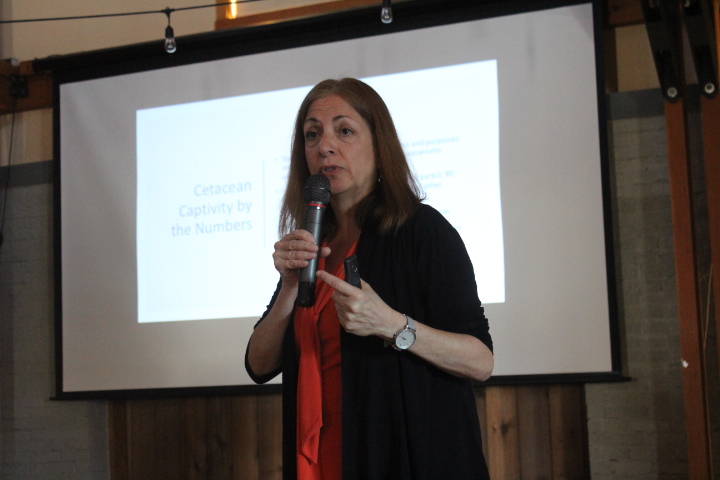In an effort to garner community input regarding a proposed whale sanctuary, three meetings were held in the San Juans about the project.
“There are sanctuaries for other large mammals like elephants,” sanctuary board President Lori Marino said, adding that she sees no reason why the same couldn’t be done for marine mammals like orcas, dolphins and belugas.
Several members of the Whale Sanctuary Project presented information about creating a sanctuary for captive whales at Brickworks on July 21. There were also meetings held on Orcas and Lopez.
According to project organizers, requirements for a whale sanctuary include access to 60-100 acres of water with a minimum depth of 50 feet in at least half of the sanctuary; protection from extreme weather; one free of sewage, pollutants and noise; a good flushing rate; minimal human activity or boat traffic; and a separate area for medical and other special care needs.
One location the group has considered at is Deep Water Bay on Cypress Island. An area on Sucia Island is being considered as well, but has been less researched, Executive Director Charles Vinick said. There are other possible locations in Washington state, as well as British Columbia, Canada. An east coast location is also being considered for captive beluga whales.
One of the orcas they hope to bring to the sanctuary is 53-year old Tokitae. In 1970 Tokitae was taken from her family, the Southern resident orca pod known as L pod. She now spends her days in the Miami Seaquarium under the name Lolita, entertaining tourists and swimming circles in one of the smallest tanks in the country. Should the sanctuary end up in the San Juans, Tokitae would be able to spend the remainder of her days in her home waters of the Salish Sea. Orcas in captivity, Marino said, only live 15-20 years on average, compared to in the wild where they regularly exceed 50 years. Tokitae has lived well beyond an orca in captivity’s average life span.
“She is resilient,” Marino said.
The Lummi Nation has been actively trying to bring attention to Tokitae’s plight, carrying a totem pole to Miami in her honor. Members of the sanctuary project have been collaborating with the Lummi Nation in creating the sanctuary.
The group is hoping to house six to eight orcas in the facility. According to Marino, all of them would most likely be spending the rest of their lives there. A full-time veterinarian staff would be needed to care for them. Because there would already be staff and equipment, Marino and other members have said that if one of the wild Southern residents needed urgent care, the facility could help.
“Sort of like if someone asked is there a doctor in the house,” Marino said. “We would be available to help if we are needed.”
While much of the audience expressed empathy with a desire to do something positive for captive whales and dolphins, many others had concerns.
Despite noting that prior to bringing any whale into the sanctuary, each animal would be fully vetted and a comprehensive health analysis completed, audience members were afraid pathogens would spread to the wild whales in the area, especially endangered Southern residents.
Being able to rehabilitate sick or injured whales also raised red flags with many. One attendee wanted the presenters to promise that healthy resident orcas would not be captured for containment.
“I guarantee we will not be rounding up Southern residents,” Marino said.
Another question regarding rehabilitation was if the group were to take in a whale that wouldn’t be able to be released what would staff do with the whale.
Vinick replied that it was hard to say without specific details of the situation being known, but generally speaking, if the whale couldn’t be released, the sanctuary would probably opt not to take it in since that essentially meant the animal was dying. As orcas are social animals, it should spend its last days with its family.
“Do we have all the answers? By no means. Do we have some strategies? Yes,” Vinick said, explaining that the group asks themselves continuously, “Can it be done? How can it be done? Will it be meaningful to the whales?”
For more information about the sanctuary project, visit https://whalesanctuaryproject.org/.



